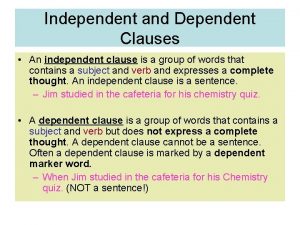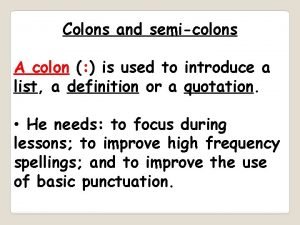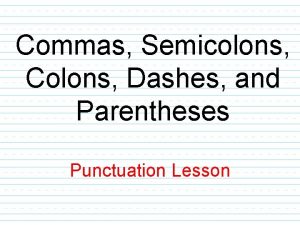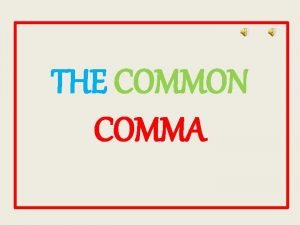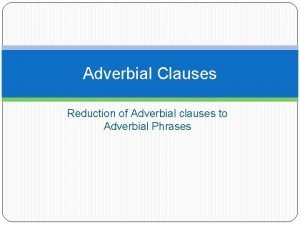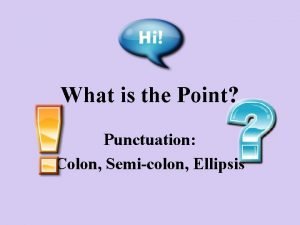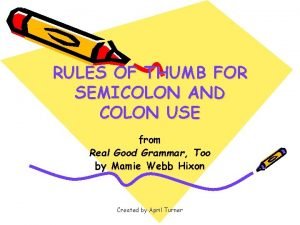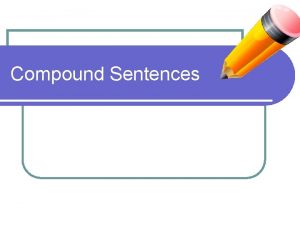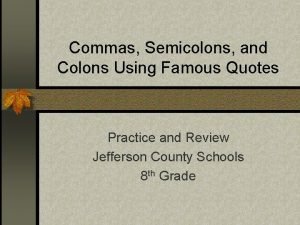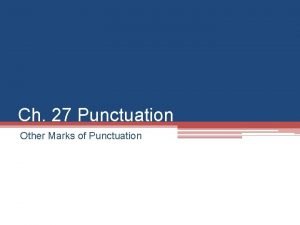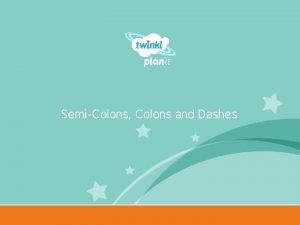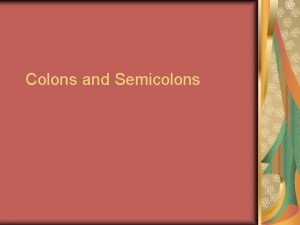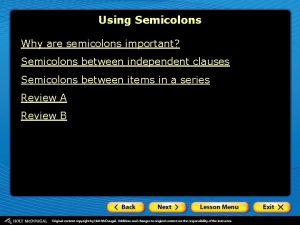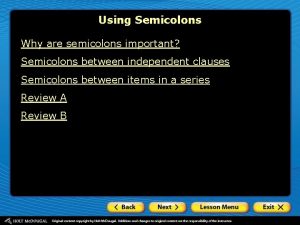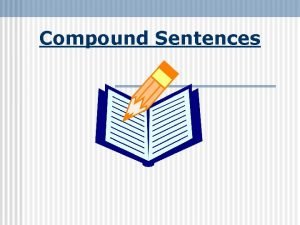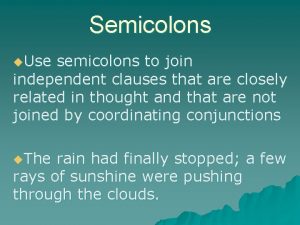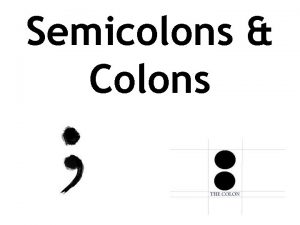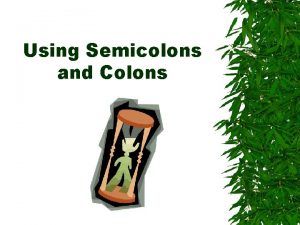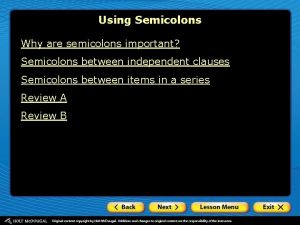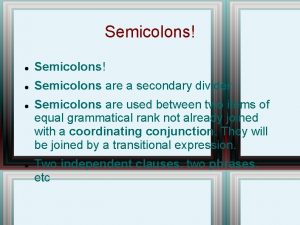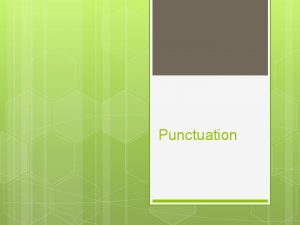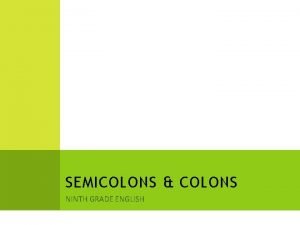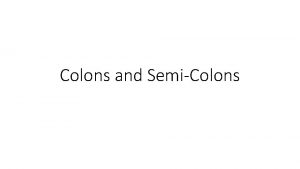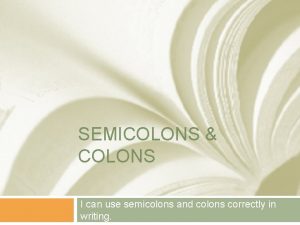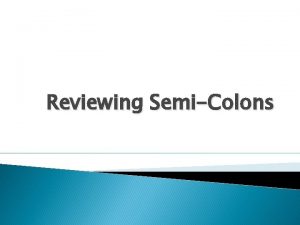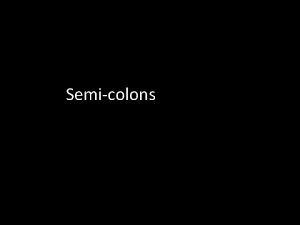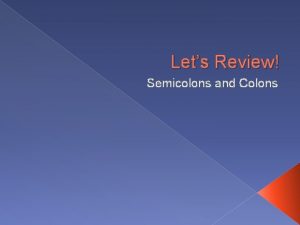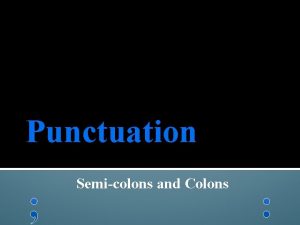Semicolons l Use semicolons to join independent clauses



















- Slides: 19

Semicolons l. Use semicolons to join independent clauses that are closely related in thought and that are not joined by coordinating conjunctions l. The winds had increased; heavy clouds began to obscure the sun.

Semicolons l Use semicolons b/w independent clauses joined by conjunctive adverbs or transitional expressions. l The ice made walking a challenge; nevertheless, I never fell. l Dennis plays football well; in fact, he hopes to earn a football scholarship.

Semicolons l Use semicolons b/w items in a series if the items include commas. l The CEO has appointed the following people to chair the following departments: Ronald Wood, manufacturing; Charles Watts, membership; Brian Jones, financial; and William Perks, legal.

Colons l Use a colon to indicate what follows, especially after expressions like “as follows” and “the following. ” l Prior to 1722, the Iroquois Confederation consisted of five American Indian nations: Mohawk, Oneida, Onondaga, Cayuga, and Seneca.

Colons l Use a colon before long formal statements or quotations. l Lincoln’s Gettysburg Address begins with these famous words: “Fourscore and seven years ago…” l Walter never says the following: “I hate eggs and I hate you. ”

Colons l Use colon between independent clauses when the second clause explains or restates the idea of the first. l Liz felt she had done something good: She had raised morale for the staff coordinators. l Thomas Jefferson had many talents: He was a writer, a politician, an architect, and an inventor.

Colons l Use Colons with conventional uses: l Time— 10: 55 P. M. l Between chapter and verse in Bible passage —Mark 10: 12 l Between Title and Subtitle—Superman IV: The Quest for Peace. l After salutation in a business letter—Dear Sir or Madam:

Dashes l Use to indicate abrupt break l The company’s leading earner—I can’t remember his name—is not a nice person. l Create the dash by pressing the hyphen key twice and keep typing; a dash will appear.

Italics l Italicizing an item is the same as underlining it. l You should never do both. l Italicize movies, albums, magazines, books, games, works of art.

Quotation Marks l Use quotation marks when quoting material someone else wrote in text you are writing. l Use quotation marks with l poems, songs, short stories. l Dialogue, l Copy examples from page 740

Quotation Marks l Commas are always placed inside quotation marks l Semi-colons and colons are placed outside quotation marks l If question mark or exclamation mark is part of quotation it is placed inside of quotation marks. Otherwise they are placed outside.

Quotation Marks l EX 1—According to the author, “people should never go swimming when they have open head wounds. ” l EX 2—”Ode on a Grecian Urn” poem title 3—”I hope, ” said Bob “that we don’t have any homework. ”

Quotation Marks l Commas and periods go inside of quotation marks. l EX 1—Steinbeck writes that Lennie is “strong as a bull, but he is not much of a thinker, ” suggesting Lennie will struggle in life. l EX 2—In “Spring, ” Edna St. Vincent Millay takes a negative view of spring.

Quotation Marks l Question marks and exclamation points are placed inside quotation marks if quotation is a question or exclamation. l EX 1—”What time do we leave? ” Bob asked. l EX 2—”I am super excited!” Ted exclaimed.

Quotation Marks l Punctuation outside of quotation marks: l Semi-colons and colons l EX—Bob said, “I do not want what I haven’t got”; which made me reassess my life. l The following students were named “best athlete”: Frank Bello and Saul Hudson.

Quotation Marks l Question marks and exclamation marks are placed outside quotation marks if quotation is not a question if an exclamation. l EX 1—Why did you shout, “It doesn’t matter”? l EX 2—Don’t say, “I’d rather not”!

Apostrophes l Used to show possession. l The l Used team’s coach, the geese’s squawking with contractions. l They’re, the possessive s is not pronounced do the following: l When l The performers’ costumes l The girls’ game

Apostrophes l It’s is a contraction of it is l Its is the possessive form of it.

Hyphen l Ex-mayor l Two-thirds l Well-designed bicycle l Self-improvement
 What does independent clause
What does independent clause When is colon used
When is colon used When to use commas semicolons colons and dashes
When to use commas semicolons colons and dashes Comma before as
Comma before as Restrictive clauses and nonrestrictive clauses
Restrictive clauses and nonrestrictive clauses Adverbial clause reduction
Adverbial clause reduction Semicolon for lists
Semicolon for lists Semicolons and colons quiz
Semicolons and colons quiz Semi colon
Semi colon Formula for compound sentence
Formula for compound sentence Famous quotes with semicolons
Famous quotes with semicolons Chapter 27 punctuation answer key
Chapter 27 punctuation answer key Dash ks2
Dash ks2 Uses of colons and semicolons
Uses of colons and semicolons Why are semicolons important
Why are semicolons important Famous quotes with semicolons
Famous quotes with semicolons Why are semicolons important
Why are semicolons important Dependent clause and independent clause
Dependent clause and independent clause What is dependent clause
What is dependent clause Logical compound sentence
Logical compound sentence
